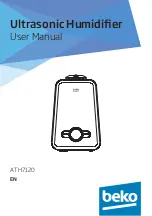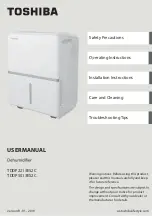
45
Decommissioning
Before carrying out this procedure, it is essential that the technician is completely familiar with the equip-
ment and all its detail. It is recommended good practice that all refrigerants are recovered safely.
Prior to the task being carried out, an oil and refrigerant sample shall be taken in case analysis is required
prior to re-use of reclaimed refrigerant. It is essential that electrical power is available before the task is
commenced.
a) Become familiar with the equipment and its operation.
b) Isolate system electrically.
c) Before attempting the procedure ensure that:
• mechanical handling equipment is available, if required, for handling refrigerant cylinders;
• all personal protective equipment is available and being used correctly;
• the recovery process is supervised at all times by a competent person;
• recovery equipment and cylinders conform to the appropriate standards.
d) Pump down refrigerant system, if possible.
e) If a vacuum is not possible, make a manifold so that refrigerant can be removed from various parts
of the system.
f) Make sure that cylinder is situated on the scales before recovery takes place.
g) Start the recovery machine and operate in accordance with manufacturer´s instructions.
h) Do not overfill cylinders. (No more than 80 % volume liquid charge).
i) Do not exceed the maximum working pressure of the cylinder, even temporarily.
j) When the cylinders have been filled correctly and the process completed, make sure that the cylinders
and the equipment are removed from site promptly and all isolation valves on the equipment are closed
off.
k) Recovered refrigerant shall not be charged into another refrigeration system unless it has been
cleaned and checked.
Labelling
Equipment shall be labelled stating that it has been de-commissioned and emptied of refrigerant. The
label shall be dated and signed. Ensure that there are labels on the equipment stating the equipment
contains flammable refrigerant.
Recovery
When removing refrigerant from a system, either for servicing or decommissioning, it is recommended
good practice that all refrigerants are removed safely.
When transferring refrigerant into cylinders, ensure that only appropriate refrigerant recovery cylinders
are employed. Ensure that the correct number of cylinders for holding the total system charge is availa-
ble. All cylinders to be used are designated for the recovered refrigerant and labelled for that refrigerant
(i.e. special cylinders for the recovery of refrigerant). Cylinders shall be complete with pressure relief
Summary of Contents for DH5020
Page 2: ...1 4 7 5 6 2 3...
Page 3: ...9 8 15 10 21 11 12 13 19 18 17 14 16 10 20 Humidity setting Humidity setting...
Page 62: ...62 UFESA 8 30 cm...
Page 63: ...63 20 cm T F 250V 3 15 4 m2 R290 60g...
Page 64: ...64...
Page 65: ...65 0 C...
Page 66: ...66 B B TRENDS SL 1 2 3 4 5 6 7 8 9 10 11 12 13 14 15 16 17 18 19 20 21 1...
Page 67: ...67 50 50 70 70 3 0 24 30 80 14 0 24 0 24...
Page 68: ...68 3...
Page 69: ...69 2 30 0 C 10 C 30...
Page 70: ...70 2 4...
Page 71: ...71 Le volume d...
Page 72: ...72 2012 19 C02...
Page 73: ...73...
Page 74: ...74...
Page 75: ...75 25...
Page 76: ...76...
Page 77: ...77 a b c d e f g h 80 i...
Page 78: ...78 j k...
Page 79: ...79...
Page 80: ...80 2 4 06 092R...
Page 81: ...81 UFESA 8 30 20 250 F T 3 15...
Page 83: ...83 0 B B TRENDS SL 1 2 3 4 5 6 7 8 9 10 11 12 13 14 15 16 17 18 19 20 21...
Page 84: ...84 30 ON OFF 2 4...
Page 85: ...85 ON OFF Continuous mode mode mode 3 2 0 30 10...
Page 86: ...86 C02...
Page 87: ...87 WEEE EU 91 2102...
Page 89: ...89 25...
Page 90: ...90...
Page 91: ...91 08...
Page 94: ...94 B B TRENDS SL e B B TRENDS SL 1999 44 B B TRENDS SL B B TRENDS SL...
Page 95: ...95 B B TRENDS SL 23 2003 B B TRENDS SL 2003 10 B B TRENDS SL...
















































